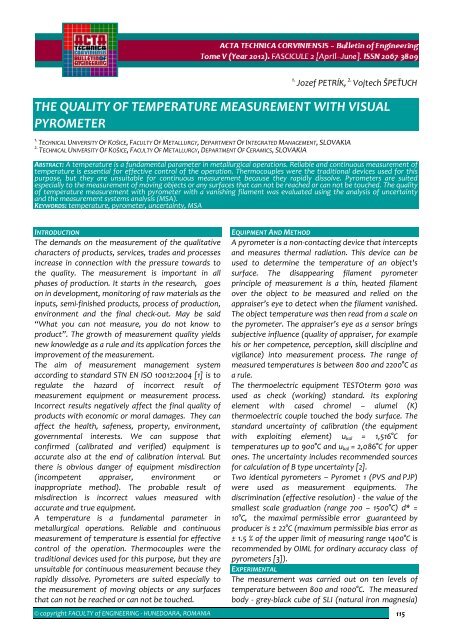Editorial & Advisory Board - Acta Technica Corviniensis
Editorial & Advisory Board - Acta Technica Corviniensis
Editorial & Advisory Board - Acta Technica Corviniensis
You also want an ePaper? Increase the reach of your titles
YUMPU automatically turns print PDFs into web optimized ePapers that Google loves.
1.<br />
Jozef PETRÍK, 2. Vojtech ŠPEŤUCH<br />
THE QUALITY OF TEMPERATURE MEASUREMENT WITH VISUAL<br />
PYROMETER<br />
1.<br />
TECHNICAL UNIVERSITY OF KOŠICE, FACULTY OF METALLURGY, DEPARTMENT OF INTEGRATED MANAGEMENT, SLOVAKIA<br />
2.<br />
TECHNICAL UNIVERSITY OF KOŠICE, FACULTY OF METALLURGY, DEPARTMENT OF CERAMICS, SLOVAKIA<br />
ABSTRACT: A temperature is a fundamental parameter in metallurgical operations. Reliable and continuous measurement of<br />
temperature is essential for effective control of the operation. Thermocouples were the traditional devices used for this<br />
purpose, but they are unsuitable for continuous measurement because they rapidly dissolve. Pyrometers are suited<br />
especially to the measurement of moving objects or any surfaces that can not be reached or can not be touched. The quality<br />
of temperature measurement with pyrometer with a vanishing filament was evaluated using the analysis of uncertainty<br />
and the measurement systems analysis (MSA).<br />
KEYWORDS: temperature, pyrometer, uncertainty, MSA<br />
INTRODUCTION<br />
The demands on the measurement of the qualitative<br />
characters of products, services, trades and processes<br />
increase in connection with the pressure towards to<br />
the quality. The measurement is important in all<br />
phases of production. It starts in the research, goes<br />
on in development, monitoring of raw materials as the<br />
inputs, semi‐finished products, process of production,<br />
environment and the final check‐out. May be said<br />
“What you can not measure, you do not know to<br />
product”. The growth of measurement quality yields<br />
new knowledge as a rule and its application forces the<br />
improvement of the measurement.<br />
The aim of measurement management system<br />
according to standard STN EN ISO 10012:2004 [1] is to<br />
regulate the hazard of incorrect result of<br />
measurement equipment or measurement process.<br />
Incorrect results negatively affect the final quality of<br />
products with economic or moral damages. They can<br />
affect the health, safeness, property, environment,<br />
governmental interests. We can suppose that<br />
confirmed (calibrated and verified) equipment is<br />
accurate also at the end of calibration interval. But<br />
there is obvious danger of equipment misdirection<br />
(incompetent appraiser, environment or<br />
inappropriate method). The probable result of<br />
misdirection is incorrect values measured with<br />
accurate and true equipment.<br />
A temperature is a fundamental parameter in<br />
metallurgical operations. Reliable and continuous<br />
measurement of temperature is essential for effective<br />
control of the operation. Thermocouples were the<br />
traditional devices used for this purpose, but they are<br />
unsuitable for continuous measurement because they<br />
rapidly dissolve. Pyrometers are suited especially to<br />
the measurement of moving objects or any surfaces<br />
that can not be reached or can not be touched.<br />
EQUIPMENT AND METHOD<br />
A pyrometer is a non‐contacting device that intercepts<br />
and measures thermal radiation. This device can be<br />
used to determine the temperature of an object's<br />
surface. The disappearing filament pyrometer<br />
principle of measurement is a thin, heated filament<br />
over the object to be measured and relied on the<br />
appraiser’s eye to detect when the filament vanished.<br />
The object temperature was then read from a scale on<br />
the pyrometer. The appraiser’s eye as a sensor brings<br />
subjective influence (quality of appraiser, for example<br />
his or her competence, perception, skill discipline and<br />
vigilance) into measurement process. The range of<br />
measured temperatures is between 800 and 2200°C as<br />
a rule.<br />
The thermoelectric equipment TESTOterm 9010 was<br />
used as check (working) standard. Its exploring<br />
element with cased chromel – alumel (K)<br />
thermoelectric couple touched the body surface. The<br />
standard uncertainty of calibration (the equipment<br />
with exploiting element) u kal = 1,516°C for<br />
temperatures up to 900°C and u kal = 2,086°C for upper<br />
ones. The uncertainty includes recommended sources<br />
for calculation of B type uncertainty [2].<br />
Two identical pyrometers – Pyromet 1 (PVS and PJP)<br />
were used as measurement equipments. The<br />
discrimination (effective resolution) ‐ the value of the<br />
smallest scale graduation (range 700 – 1500°C) d* =<br />
10°C, the maximal permissible error guaranteed by<br />
producer is ± 22°C (maximum permissible bias error as<br />
± 1.5 % of the upper limit of measuring range 1400°C is<br />
recommended by OIML for ordinary accuracy class of<br />
pyrometers [3]).<br />
EXPERIMENTAL<br />
The measurement was carried out on ten levels of<br />
temperature between 800 and 1000°C. The measured<br />
body ‐ grey‐black cube of SLI (natural iron magnesia)<br />
© copyright FACULTY of ENGINEERING ‐ HUNEDOARA, ROMANIA 115

















